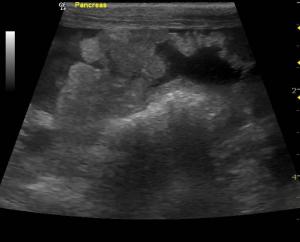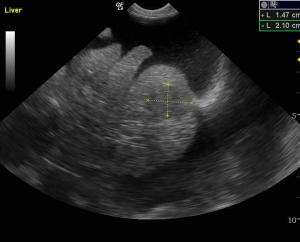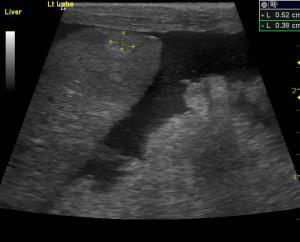Clinical Differential Diagnosis
Bacterial peritonitis. Feline infectious peritonitis. Neoplasia- intra-abdominal, liver, spleen, kidney, pancreas, mesenteric lymph node. Chemical - urine, bile.
Image Interpretation
The abdomen in this patient presented moderate amount of echogenic free fluid. Multiple heterogenous nodular changes were noted which were hypoechoic and hyperechoic throughout the liver. This is suggestive for metastatic event. Some internal structure deviation was noted. The deep right liver revealed a collapsed gallbladder with surrounding parenchymal nodular changes with impingement upon the gallbladder. The vena cava was normal. The hepatic veins were subnormal in size. This is indicative of an increased possibility of feline infectious peritonitis. The pancreatic region revealed multiple nodular hypoechoic changes with irregular surrounding omentum.
Sonographic Differential Diagnosis
Bi-cavitary effusion. Nodular pancreatic and hepatic changes. This is highly suggestive for dual cavity neoplasia such as carcinomatosis or possible feline infectious peritonitis. An abdominocentesis with cytospin and immediate slide preparation would be recommended for a definitive diagnosis. Alternatively, fine-needle aspirates of the pancreas and liver nodules would be warranted. Very poor long term prognosis.
Sampling
FNA of liver revealed carcinoma (suspected metastatic). FNA of pancreas: carcinoma. Comments: Given the appearance of the slides as well as the sonographic description, the pancreas is likely the site of primary neoplasia, with metastases to the liver. The neoplastic cells appear epithelial but do not contain zymogen granules typical of normal pancreatic cells. This could be because the cells are sufficiently anaplastic as to have lost this feature, but other sources should be considered as well.
DX
Pancreas: carcinoma. Liver: carcinoma (suspected metastatic).
Outcome
The patient was humanely euthanized.




